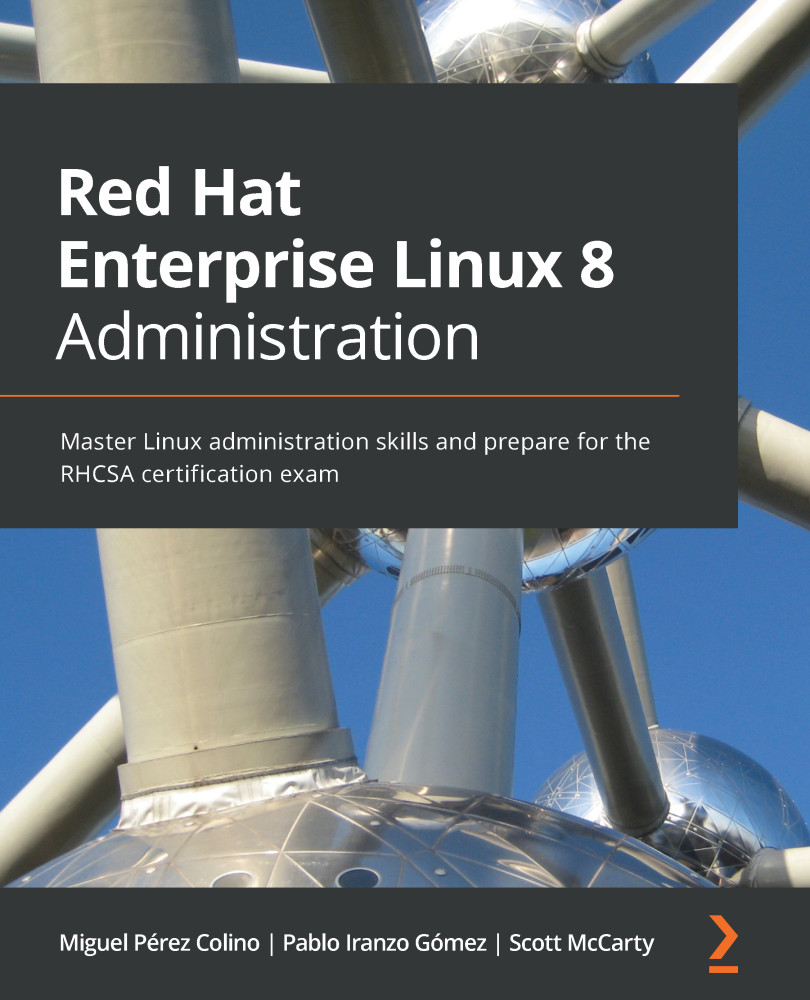-
Book Overview & Buying

-
Table Of Contents

Red Hat Enterprise Linux 8 Administration
By :

Red Hat Enterprise Linux 8 Administration
By:
Overview of this book
Whether in infrastructure or development, as a DevOps or site reliability engineer, Linux skills are now more relevant than ever for any IT job, forming the foundation of understanding the most basic layer of your architecture. With Red Hat Enterprise Linux (RHEL) becoming the most popular choice for enterprises worldwide, achieving the Red Hat Certified System Administrator (RHCSA) certification will validate your Linux skills to install, configure, and troubleshoot applications and services on RHEL systems.
Complete with easy-to-follow tutorial-style content, self-assessment questions, tips, best practices, and practical exercises with detailed solutions, this book covers essential RHEL commands, user and group management, software management, networking fundamentals, and much more. You'll start by learning how to create an RHEL 8 virtual machine and get to grips with essential Linux commands. You'll then understand how to manage users and groups on an RHEL 8 system, install software packages, and configure your network interfaces and firewall. As you advance, the book will help you explore disk partitioning, LVM configuration, Stratis volumes, disk compression with VDO, and container management with Podman, Buildah, and Skopeo.
By the end of this book, you'll have covered everything included in the RHCSA EX200 certification and be able to use this book as a handy, on-the-job desktop reference guide.
This book and its contents are solely the work of Miguel Pérez Colino, Pablo Iranzo Gómez, and Scott McCarty. The content does not reflect the views of their employer (Red Hat Inc.). This work has no connection to Red Hat, Inc. and is not endorsed or supported by Red Hat, Inc.
Table of Contents (25 chapters)
Preface
Section 1: Systems Administration – Software, User, Network, and Services Management
 Free Chapter
Free Chapter
Chapter 1: Installing RHEL8
Chapter 2: RHEL8 Advanced Installation Options
Chapter 3: Basic Commands and Simple Shell Scripts
Chapter 4: Tools for Regular Operations
Chapter 5: Securing Systems with Users, Groups, and Permissions
Chapter 6: Enabling Network Connectivity
Chapter 7: Adding, Patching, and Managing Software
Section 2: Security with SSH, SELinux, a Firewall, and System Permissions
Chapter 8: Administering Systems Remotely
Chapter 9: Securing Network Connectivity with firewalld
Chapter 10: Keeping Your System Hardened with SELinux
Chapter 11:System Security Profiles with OpenSCAP
Section 3: Resource Administration – Storage, Boot Process, Tuning, and Containers
Chapter 12: Managing Local Storage and Filesystems
Chapter 13: Flexible Storage Management with LVM
Chapter 14: Advanced Storage Management with Stratis and VDO
Chapter 15: Understanding the Boot Process
Chapter 16: Kernel Tuning and Managing Performance Profiles with tuned
Chapter 17: Managing Containers with Podman, Buildah, and Skopeo
Section 4: Practical Exercises
Chapter 18: Practice Exercises – 1
Chapter 19: Practice Exercise – 2
Other Books You May Enjoy
